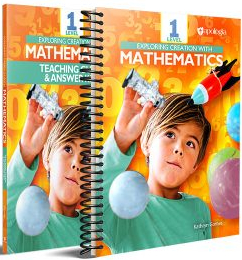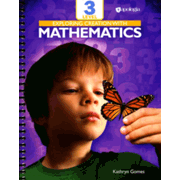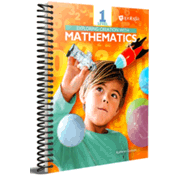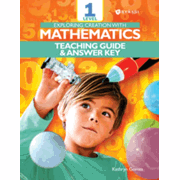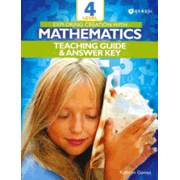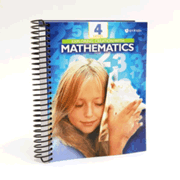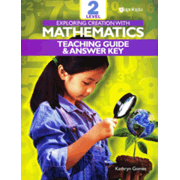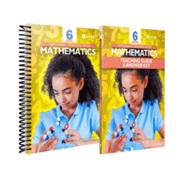Exploring Creation with Mathematics is a relatively new math series from Apologia. Level 1 through Level 6 (for grades one through six) were designed for Christian homeschoolers although the Christian content is almost completely isolated into the “Seeing Our Creator in..." introductory pages at the beginning of each unit.
The courses utilize hands-on activities to introduce new concepts, worksheets for practice, games to enhance learning, and end-of-unit projects that involve many concepts learned in that unit. There is a strong emphasis on mastering both math facts and conceptual understanding. The courses link mathematical concepts to the real world, primarily through word problems. And each title is visually connected to a science theme with icons and illustrations such as those related to insects in Level 3.
Each course has a large, plastic-spiral-bound, consumable student textbook as the primary resource for both student and teacher. It contains both the text and the worksheets. The Teaching Guide & Answer Key for each course is also essential. Teaching Guides are available as softcover, printed books or as ebooks in Kindle and Apple formats.
A bonus with each course is a password to a dedicated Book Extras web page with additional helpful tools such as printable pages for games and activities and links to helpful websites. (Many of these pages are also at the back of the Teaching Guide.) Book Extras access information is in the front of each student textbook in the course instructions.
The student textbooks arrange each course into five to seven units. Each unit is divided into chapters, and each chapter has several lessons. These courses each have just over 100 lessons (up to 116 in Level 5), and one or two additional days are scheduled as project days at the end of most units. The teaching guides have optional lesson-plan charts showing lessons for four days per week. The intent is for students to complete one lesson per day, ending most units with a project day.
Most days begin with a five-to-ten-minute Daily Skills Practice that reviews concepts previously taught. For instance, in the fourth unit of Level 2 (which teaches addition and subtraction with three-digit numbers), the skill practice is for counting coins and telling time, the concepts that were taught in the third unit. The teaching guide lists games and activities that can be used for Daily Skills Practice. For some units, students will do only one type of skill practice each day, although the level of difficulty might gradually increase from day to day. Other units have more than one type of skill practice.
The lesson itself is taught from the student book which is printed in full color with lots of images. In the primary grades, parents can read the text aloud and guide students through the activities or written work in the student book. All the books are written in a conversational style, directly to students, so they can work independently as soon as they can read and understand the lesson material.
These courses use concrete, representational, and abstract instruction. That means new concepts are introduced with concrete objects, then taught again with visual representations (images), and then students learn concepts abstractly using numbers and mathematical symbols. That’s the overarching approach, but lessons don’t always use the steps in that order. For instance, Lesson 15 in Level 2 is about place value. Students use base ten blocks to model three-digit numbers (concrete). They use the numbers 3, 6, and 7 to write their own 3-digit number (abstract). They model their number with base ten blocks (connecting the abstract to the concrete), and they draw a picture to show the base ten blocks for their number (connecting representational to the abstract).
After instruction, these courses continue to use many different activities to ensure both conceptual understanding and mastery of the math facts, including many that are hands-on. Some of the hands-on resources used are ten frames (grids of ten squares on paper), LEGO® bricks, linking cubes, base ten blocks, dominoes, playing cards, dice, counters or beans, and play dough (recipe included). You will also use many grocery store, household, and craft resources like foam cups, M&M’s®, coins, dot stickers, brads, beads, poster board, pipe cleaners, colored pencils, tape, and glue. There are separate supply lists for each unit within the teaching guides, as well as a comprehensive list at the end of each guide.
Problem-solving is done in numerous ways. While there are sometimes rows of problems to solve, the lessons use a variety of formats to present problems, such as word problems, problems within puzzles, and problem-solving within games. Pages are never overcrowded.
The teaching guides have reduced images of student text pages with overprinted answers, sometimes accompanied by tips or special instructions for teaching the lessons. At the back of each teaching guide are about 30 to 150 pages with games and activities used throughout each course, including items such as ten-frame charts, game boards, cut-and-fold pages, cards to be used for games, and much more. Parents should check the teaching guide before each lesson to pull out any pages from the back that will be used (or print these from the online Book Extras). Other than gathering and preparing hands-on resources, the lessons don't require advanced preparation.
The textbook for Level 1 begins by teaching numbers from 0 to 20 and beginning addition. The second unit continues through addition and subtraction with numbers up to 20. The third unit concentrates on the concept of place value with numbers up to 120. Students also learn to compare numbers and add two-digit numbers. The fourth unit covers two areas: measurement (including telling time) and data and graphs. The fifth unit introduces both two- and three-dimensional geometric shapes along with concepts such as a vertex (and vertices) and the fractional parts of two-dimensional shapes.
Level 2 continues addition and subtraction up through 3-digit numbers (with regrouping). It teaches numbers up through 1,000. It continues at a higher level of difficulty with telling time, measurement, data and graphs, geometric shapes, and fractional parts. It also introduces money with coins and one-dollar bills.
The first of the seven units in Level 3 reviews addition and subtraction up through 3-digit numbers (with regrouping). It then teaches both multiplication and division up through 10 x 10 and 100 ÷ 10. A unit on data and measurement covers different types of graphs, telling time, liquid measurements, and weight. A unit on fractions teaches basic concepts up through comparing fractions with the same denominators and identifying equivalent fractions with different denominators. Geometry concepts taught in the final unit include area, perimeter, polygons, circles, triangles, and angles. Review becomes more important at this level. The Daily Skills Practice activities are scheduled and described in the teacher’s guide. In addition, the end of each chapter provides sets of mixed review problems.
In Level 4, the first unit covers place value, the expanded form for writing numbers, rounding, estimating answers, and word-problem solving. Unit 2 starts by reviewing multiplication skills and ends with two-digit multiplication. Unit 3 covers geometry concepts. Unit 4 covers division skills, including vertical division. Unit 5 focuses on measurement, and Unit 6 covers fractions and decimals.
Level 5's six units are titled Whole Numbers, Fractions, Decimals, Geometry and Measurement, Percents, and Graphing. The course thoroughly covers decimals and percents. It teaches quite a bit of geometry, introduces graphing on a coordinate grid, and teaches conversions between metric and customary measurements. The textbook has 463 pages, but the pages are uncrowded. Students continue to use manipulatives and games. These features make the course suitable for a wide range of learning styles as well as those who still need concrete methods of learning math.
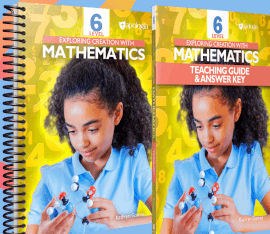 Level 6 has six units titled:
Level 6 has six units titled:
1. Whole Numbers, Decimals, and Fractions
2. Ratios, Rates, and Percents
3. Measurement, Data, and Probability
4. Negative Numbers
5. Introduction to Algebra
6. Geometry
The algebra unit teaches topics such as simplifying algebraic expressions, inequalities, negative inequalities, the coordinate plane, and graphing equations. Geometry lessons teach about area, perimeter, and volume of two- and three-dimensional figures.
Summary
The Exploring Creation with Mathematics courses require parent involvement most of the time for at least the first two levels since students will need assistance in reading the lessons and working with the manipulatives. But that investment of time to create hands-on, interactive lessons should make the courses effective and enjoyable for both parents and students. As students become more independent, the courses still include hands-on activities, but students can complete most of them on their own.

